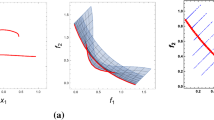Abstract
This paper deals with multiobjective programming in which the objective functions are nonsymmetric distances (derived from different gauges) to the points of a fixed finite subset of ℝn. It emphasizes the case in which the gauges are polyhedral. In this framework the following result is known: if the gauges are polyhedral, then each Pareto optimum is the solution to a Fermat—Weber problem with strictly positive coefficients. We give a new proof of this result, and we show that it is useful in finding the whole set of efficient points of a location problem with polyhedral gauges. Also, we characterize polyhedral gauges in terms of a property of their subdifferential.
Similar content being viewed by others
References
C. Berge,Espaces Topologiques, Fonctions Multivoques (Dunod, Paris, 1959).
J.M. Borwein, “Proper efficient points for maximization with respect to cones,”SIAM Journal on Control and Optimization 15 (1977) 57–63.
G.R. Britan and T.L. Magnanti, “The structure of admissible points with respect to cone dominance,”Journal of Optimization Theory and Applications 29 (1979) 573–614.
A. Brønsted,An Introduction to Convex Polytopes (Springer, New York, 1983).
L.G. Chalmet, R.L. Francis and A. Kolen, “Finding efficient solutions for rectilinear distance location problem efficiently,”European Journal of Operational Research 6 (1981) 117–124.
R. Durier, “Sets of efficiency in a normed space and inner product,” in: J. Jahn and W. Krabs, eds.,Recent advances and historical development of vector optimization, Lecture Notes in Economics and Mathematical Systems, Vol. 294 (Springer, Berlin, 1987) pp. 114–128.
R. Durier, “Meilleure approximation en norme vectorielle et théorie de la localisation,”RAIRO Modelisation Mathématique et Analyse Numérique 21 (1987) 605–626.
R. Durier, “Weighting factor results in vector optimization,”Journal of Optimization Theory and Applications 58 (1988) 411–430.
R. Durier and C. Michelot, “Geometrical properties of the Fermat-Weber problem,”European Journal of Operational Research 20 (1985) 332–343.
R. Durier and C. Michelot, “Sets of efficient points in a normed space,”Journal of Mathematical Analysis and Applications 117 (1986) 506–528.
D. Gale,The Theory of Linear Economic Models (McGraw-Hill, New York, 1960).
A.M. Geoffrion, “Proper efficiency and the theory of vector maximization,”Journal of Mathematical Analysis and Applications 22 (1968) 618–630.
P. Hansen, J. Perreur and J.F. Thisse, “Location theory, dominance and convexity: some further results,”Operations Research 28 (1980) 1241–1250.
P. Hansen and J.F. Thisse, “Recent advances in continuous location theory,”Sistemi Urbani 1 (1983) 33–54.
J.-B. Hiriart-Urruty, “Images of connected sets by semicontinuous multifunctions,”Journal of Mathematical Analysis and Applications 111 (1985) 407–422.
S. Karlin,Mathematical Methods and Theory in Games, Programming, and Economics, Vol I (Addison-Wesley, Reading, MA, 1959).
H.W. Kuhn, “A pair of dual nonlinear programs,” in: J. Abadie, ed.,Methods of Nonlinear Programming (North-Holland, Amsterdam, 1967) pp 37–54.
H.W. Kuhn, “A note on Fermat's problem,”Mathematical Programming 4 (1973) 98–107.
L. McLinden, “Polyhedral extension of some theorems of linear programming,”Mathematical Programming 24 (1982) 162–176.
H. Minkowski,Theorie der Konvexen Körper, Gesammelte Abhandlugen, Vol. II (Teubner, Berlin, 1911).
P.H. Naccache, “Connectedness of the set of nondominated outcomes in multicriteria optimization,”Journal of Optimization Theory and Applications 25 (1978) 459–467.
F. Plastria, “Continuous location problems and cutting plane algorithms,” Thesis, Vrije Universiteit Brussel (Brussels, 1983).
R.T. Rockafellar,Convex Analysis (Princeton University Press, Princeton, NJ, 1970).
J.F. Thisse, J.E. Ward and R.E. Wendell, “Some properties of location problems with block and round norms,”Operations Research 32 (1984) 1309–1327.
J.E. Ward and R.E. Wendell, “Characterizing efficient points in location problems under the one-infinity norm,” in: J.F. Thisse and H.G. Zoller, eds.,Locational analysis of public facilities, Studies in Mathematical and Managed Economics, Vol. 31 (North-Holland, Amsterdam, 1983) pp. 413–429.
A. Weber,Über den Standort der Industrien (Tübingen, 1909). [English translation:The Theory of the Location of Industries (Chicago University Press, Chicago, IL, 1929).]
R.E. Wendell and A.P. Hurter, “Location theory, dominance and convexity,”Operations Research 21 (1973) 314–321.
R.E. Wendell, A.P. Hurter and T.J. Lowe, “Efficient points in location problems,”AIEE Transactions 9 (1973) 238–246.
P.L. Yu, “Cone convexity, cone extreme points and nondominated solutions in decision problems with multiobjectives,”Journal of Optimization Theory and Applications 14 (1974) 319–377.
P.L. Yu and M. Zeleny, “The set of all nondominated solutions in linear cases and a multicriteria simplex method,”Journal of Mathematical Analysis and Applications 49 (1975) 430–468.
Author information
Authors and Affiliations
Rights and permissions
About this article
Cite this article
Durier, R. On Pareto optima, the Fermat-Weber problem, and polyhedral gauges. Mathematical Programming 47, 65–79 (1990). https://doi.org/10.1007/BF01580853
Received:
Revised:
Issue Date:
DOI: https://doi.org/10.1007/BF01580853




